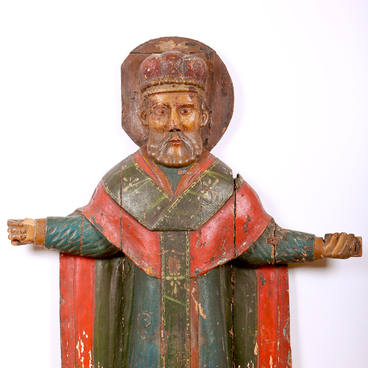In the exhibition of the Kasimov Museum-Reserve, one can see the traditional costume of a peasant woman of the Kasimov District, the Ryazan Governorate of the 19th century. Its mandatory part was the navershnik — a piece of clothing that was worn over a shirt and homespun woolen skirt. Its sleeves were shorter than the sleeves of the shirt, or completely absent. The festive navershniks were sewn from white sackcloth — dense, most often linen or hemp fabric with a plain weave of threads with overlap. At first, the fabric was woven at home, and later — in factories.
The average length of the garment was 80 centimeters — it reached the hips or was slightly lower. Everyday navershniks were sewn from striped linen — coarse homespun fabric made of multicolored threads. There were several types of clothing, depending on the cut. Tunic-shaped navershniks were created straight. The round ones were sewn flared downwards. And the ‘gored’ ones were cut with a slit at the back — it formed two large gores.
Navershniks had an oval or square neckline with a small placket in the front, which was fastened with a button. Sometimes the placket was placed on the left side of the chest — imitating men’s shirts.
The navershnik was the final layer of the women’s costume, so it was richly decorated with additional details: woven patterns, embroidery, lacing, braid, sequins, beads, and fringe. The decor was placed everywhere: on the collar and shoulders, on the sides and back. When the craftswomen sewed pieces of fabric, they inserted special braided lace stitches or patterned stripes, like that of navershnik from the museum collection. The seams were decorated at the edges with multicolored threads. By the patterns on the navershnik, one could determine where its owner came from and how old she was.
In various districts of the Ryazan Governorate, the navershniks had different names. For example, in the Yegoryevsk District they were called ‘nagruden’, ‘nagrudnik’, ‘sundress’. In Ranenburg and Dankov Districts, the garment was called ‘nagruden’, ‘nagrudnik’. In Sapozhok District — ‘navershnik’, ‘nosov’, ‘nosovets’, ‘nosovchik’, ‘nagruden’, ‘nagrudnik’. In Kasimov District, the garment was called ‘shorgan’, ‘gunka’, ‘sundress’, ‘nagrudnik’, ‘nosovchik’, ‘nosovka’, in Shatsk District — ‘nosovchik’, ‘nagrudnik’, and in Skopin District — ‘codman’.
The average length of the garment was 80 centimeters — it reached the hips or was slightly lower. Everyday navershniks were sewn from striped linen — coarse homespun fabric made of multicolored threads. There were several types of clothing, depending on the cut. Tunic-shaped navershniks were created straight. The round ones were sewn flared downwards. And the ‘gored’ ones were cut with a slit at the back — it formed two large gores.
Navershniks had an oval or square neckline with a small placket in the front, which was fastened with a button. Sometimes the placket was placed on the left side of the chest — imitating men’s shirts.
The navershnik was the final layer of the women’s costume, so it was richly decorated with additional details: woven patterns, embroidery, lacing, braid, sequins, beads, and fringe. The decor was placed everywhere: on the collar and shoulders, on the sides and back. When the craftswomen sewed pieces of fabric, they inserted special braided lace stitches or patterned stripes, like that of navershnik from the museum collection. The seams were decorated at the edges with multicolored threads. By the patterns on the navershnik, one could determine where its owner came from and how old she was.
In various districts of the Ryazan Governorate, the navershniks had different names. For example, in the Yegoryevsk District they were called ‘nagruden’, ‘nagrudnik’, ‘sundress’. In Ranenburg and Dankov Districts, the garment was called ‘nagruden’, ‘nagrudnik’. In Sapozhok District — ‘navershnik’, ‘nosov’, ‘nosovets’, ‘nosovchik’, ‘nagruden’, ‘nagrudnik’. In Kasimov District, the garment was called ‘shorgan’, ‘gunka’, ‘sundress’, ‘nagrudnik’, ‘nosovchik’, ‘nosovka’, in Shatsk District — ‘nosovchik’, ‘nagrudnik’, and in Skopin District — ‘codman’.

